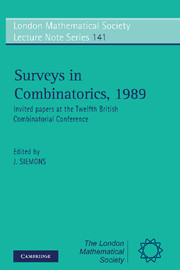Book contents
- Frontmatter
- PREFACE
- Contents
- On the theory of designs
- Designs: mappings between structured sets
- Developments based on Rado's dissertation ‘Studien zur Kombinatorik’
- Designs and automorphism groups
- On matchings and Hamiltonian cycles in random graphs
- Decompositions of complete bipartite graphs
- On the method of bounded differences
- On the use of regular arrays in the construction of t-designs
- The ‘Snake Oil’ method for proving combinatorial identities
Designs: mappings between structured sets
Published online by Cambridge University Press: 05 August 2013
- Frontmatter
- PREFACE
- Contents
- On the theory of designs
- Designs: mappings between structured sets
- Developments based on Rado's dissertation ‘Studien zur Kombinatorik’
- Designs and automorphism groups
- On matchings and Hamiltonian cycles in random graphs
- Decompositions of complete bipartite graphs
- On the method of bounded differences
- On the use of regular arrays in the construction of t-designs
- The ‘Snake Oil’ method for proving combinatorial identities
Summary
Structured sets
Every statistical design consists of two sets and a function between them. One set, T, consists of the treatments: they are under the experimenter's control, and the purpose of the experiment is to find out about them. The elements of the second set, Ω, are called plots for historical reasons. A plot is the smallest experimental unit to which an individual treatment is applied: it may or may not be a plot of land. In general the experimenter has less direct control over the attributes of the plots, and is not interested in finding out about the plots per se. Unless otherwise stated, Ω and T are always finite. Finally there is the design map ϕ from Ω to T which allocates treatments to plots; if treatment t is allocated to plot ω then ωϕ = t.
Typically one or both of the sets T and Ω is structured. I cannot give a formal definition of this concept, but examples of structures on a set include: a set of partitions; a transitive permutation group; a set of subsets; a graph; an association scheme. Many, but not all, of these structures can be specified as a set of (binary) relations with certain properties. A set will be said to be unstructured if the relations in its structure are just the equality relation E and the uncaring relation U (the direct square of the whole set) or U \ E.
- Type
- Chapter
- Information
- Surveys in Combinatorics, 1989Invited Papers at the Twelfth British Combinatorial Conference, pp. 22 - 51Publisher: Cambridge University PressPrint publication year: 1989
- 6
- Cited by

